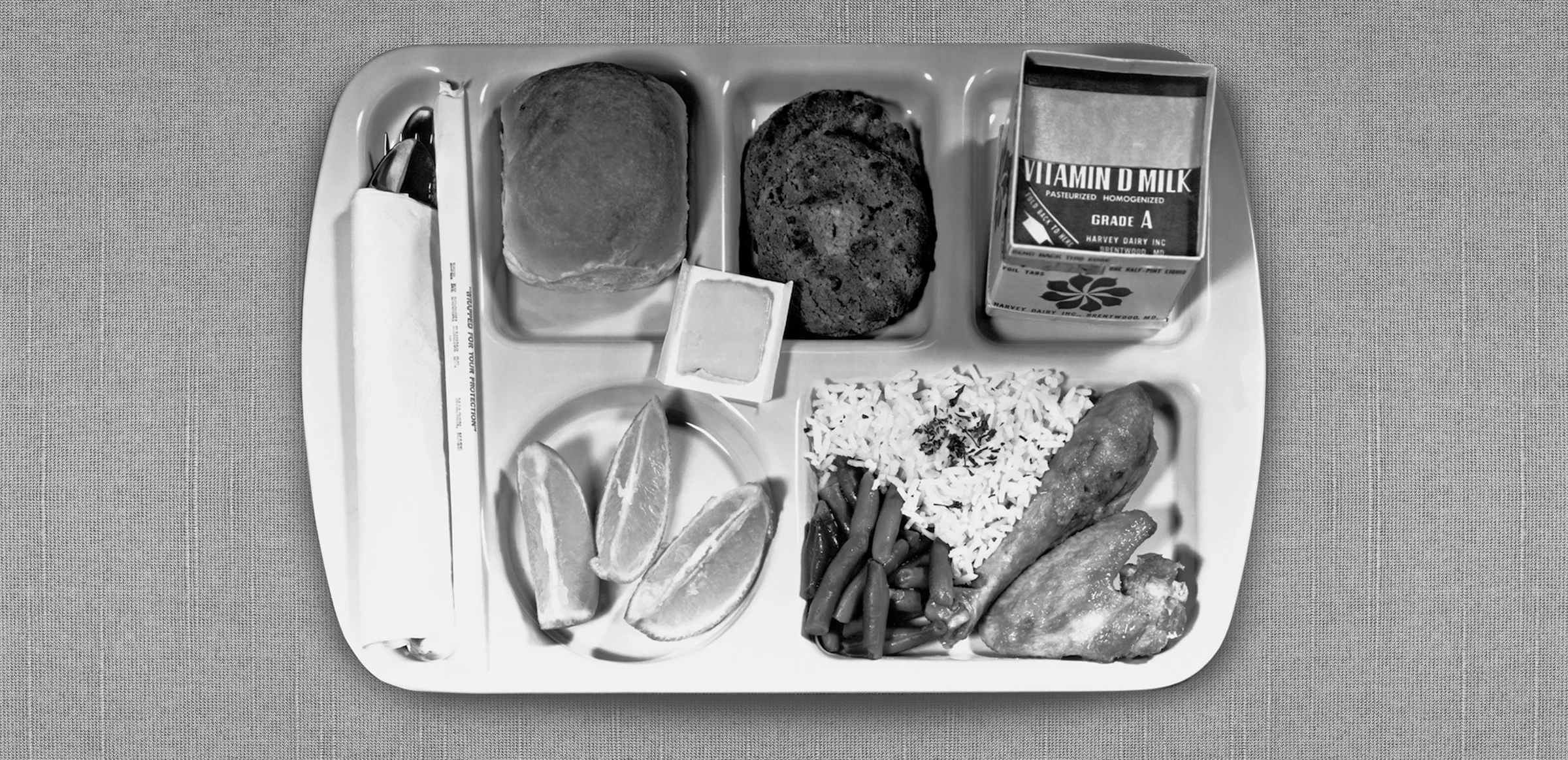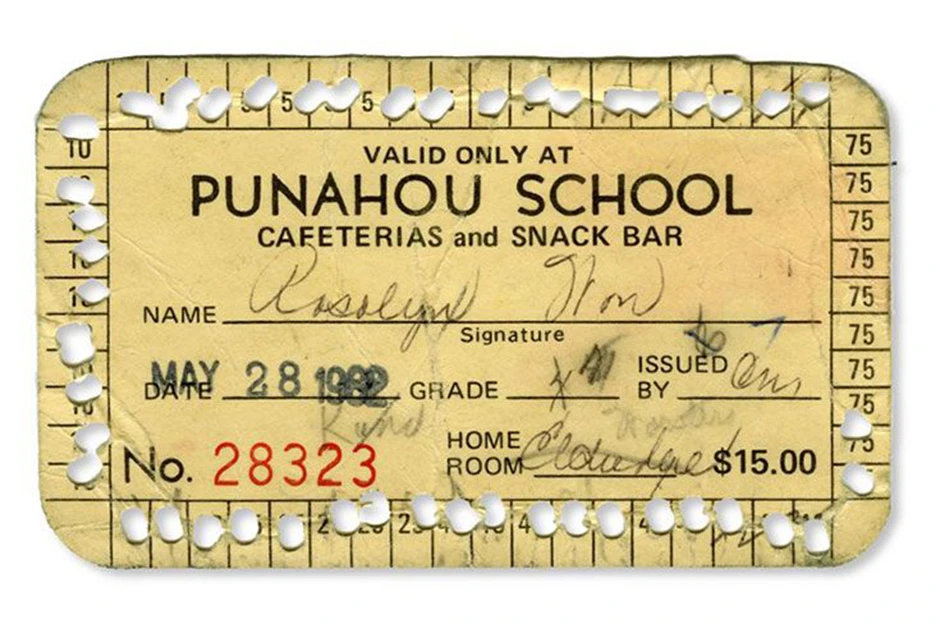
Every Child Needs
a Good School Lunch
“The right of every American school child to at least one square meal a day regardless of economic status of his parents requires no defense in logic or justice at a time when our nation is fighting for the survival of democracy.” M. F. Dickinson, National Farmers’ Union (1941)
Reflecting a popular consensus that fighting childhood hunger was a crucial part of national defense, Congress passed legislation in 1943 to protect school lunch programs, increasing federal support. Eager to maximize the efficiency and nutrition of the food provided to American troops during the war, the government adopted a set of recommended daily allowances of seven major food groups known as the “Basic 7,” requiring school menus to structure their programs around them.
The National School Lunch Program (NSLP) provided subsidies to school districts to provide free meals to all children. To receive the funds, school districts had to offer meals to poor children for free or reduced prices that conformed to the “recommended daily allowances” of the “Basic 7.”
Bowing to southern segregationists, the NSLP allowed state and local governments to impose their own requirements for funding, allowing for discrimination and enabling districts where racial segregation prevailed to deny resources to schools with large numbers of students of color. These racialized barriers to access endured for decades.
What were the impacts of the National School Lunch Program?
“It Happens Every Noon” functioned as both promotion and a step-by-step guidebook for the National School Lunch Program, encouraging its audience to start a lunch program at their school. The film shows multiple school contexts: a suburban, mostly-white school where nutritious meals help students grow up to be doctors, lawyers, and “tomorrow’s spacemen”; a mostly-Black “city school” with a kitchen delivering bagged lunches; and a remote, country school where teachers distribute the “only meal [students] will receive all day.” Rather than pointing to systemic barriers to participation or flaws in the program’s structure, the film presents lack of participation as a result of the failures of local school communities.
How did the National School Lunch Program’s funding shifts contribute to inequality?

After 1950, funding provided by the federal government for the National School Lunch Program (NSLP) declined significantly even as participation grew. Funding cuts had immediate impacts: schools replaced their lost revenue by charging students lunch fees. By the 1960’s, these fees were the largest source of funding for most school lunch programs. But for low-income schools, charging students was not a viable solution. While overall participation in the NSLP doubled in its early years, the proportion of students receiving free or reduced-price lunches through the program dropped significantly, contributing to the inequities of race and class endemic in the program.
Levine, Susan. School Lunch Politics: The Surprising History of America’s Favorite Welfare Program, (Princeton: Princeton University Press, 2008):99, 134.
Poppendieck, Janet. Free for All: Fixing School Food in America (Berkeley: University of California Press, 2010), 53.
“Whether or not a child is eligible for a free lunch is determined not by any universally accepted formula, but by local decisions about administration and financing which may or may not have anything to do with the need of the individual child. And generally speaking, the greater the need of children from a poor neighborhood, the less the community is able to meet it.” – Committee on School Lunch Participation, Their Daily Bread (1965).
The National Council on School Lunch Participation investigated the National School Lunch Program in the late 1960’s, estimating that fewer than two million of the 60 million children eligible for free or reduced-price lunch were receiving those meals, and concluding that “the school lunch program in fact [operated] for the benefit of the middle class” and contributed to racial discrimination and neglect of poor communities. New legislation resulting from the Council’s advocacy helped to establish stronger national standards of eligibility for free and reduced-price meals.
Levine, Susan. School Lunch Politics: The Surprising History of America’s Favorite Welfare Program, (Princeton: Princeton University Press, 2008): 134.
Poppendieck, Janet. Free for All: Fixing School Food in America (Berkeley: University of California Press, 2010), 60.
a Good School Lunch
In 1941, President Roosevelt convened a White House Conference of community leaders, nutrition scientists, school superintendents, farmers, and food processors to address the nutritional needs of children whose parents had joined the war effort. The Conference resulted in the development of new “Recommended Daily Allowances,” known as the “Basic 7,” to guide wartime nutrition programs. It also extended new funding for school lunch programs, reflecting the widespread belief that fighting childhood hunger was crucial to national defense.
After the war, Congress moved to make federal support for school lunch programs permanent, passing the National School Lunch Act. The National School Lunch Program (NSLP) provided funding to local school districts, but required them to structure their menus around the Basic 7 in order to receive it.
The NSLP did not include any protections against discrimination, enabling southern states — where school segregation and Jim Crow laws prevailed — to deny resources to majority-Black districts. While designed to be a universal program, nearly half of American schools could not participate in the NSLP because of these barriers. In the absence of federal intervention, such systemic barriers to access grew worse over time.
“Today, as I sign the National School Lunch Act, I feel that the Congress has acted with great wisdom in providing the basis for strengthening the nation through better nutrition for our school children … no nation is any healthier than its children or more prosperous than its farmers; and in the National School Lunch Act, the Congress has contributed immeasurably both to the welfare of our farmers and the health of our children.” – President Harry Truman, 1946
Citations
Committee on School Lunch Participation, Their Daily Bread, 1968, in Susan Levine, School Lunch Politics: The Surprising History of America’s Favorite Welfare Program (Princeton: Princeton University Press, 2008). See also Janet Poppendieck, Free for All: Fixing School Food in America (Berkeley: University of California Press, 2010).
Featured Image: The “Type A Meal” as specified by the U.S. Department of Agriculture (USDA) offered children at least a third of their recommended daily allowances for various food groups. Captured here by the USDA in June 1966, courtesy of the National Archives.
The National School Lunch Program was designed to ensure that healthy meals were available to all children in the U.S. by providing federal funding so local school districts could supply students with free lunch. But many schools, particularly those in poor and urban districts, faced systemic obstacles to accessing the funds, which disproportionately limited the program’s impact on students of color.
Museum Map
WISHING
TREE
The Proof is in Our History
- 1.Welcome
- 2.Every Child Needs a Good School Lunch - Landing
- 3.Every Child Needs a Good School Lunch - Main
- 4.How did Nixon “reform” school lunch?
- 5.How did private industry get involved in the school lunch program?
- 6.How did the National School Lunch Program work?
- 7.How did the National School Lunch Program’s funding shifts contribute to inequality?
- 8.How was the National School Lunch Program perceived?
- 9.End tour
MAZON: A Jewish Response to Hunger